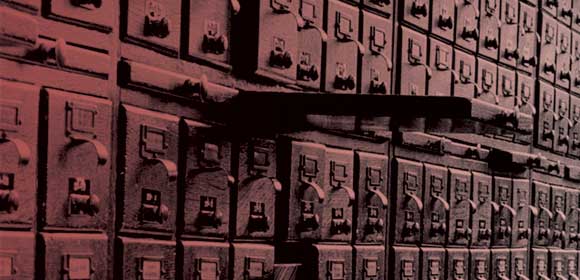
Eye on the Quads
Books on Film
The Library took quiet measures in 1969 to protect a unique resource.
The academic year 1968–69 was a turbulent one on many American university campuses, due primarily to student protests about the war in Vietnam, to which were often attached local issues of lesser importance but more immediate interest. At the University of Chicago the predominant local issue was the decision not to renew the contract of Marlene Dixon in the Department of Sociology.
In February 1969 at the University of Illinois, which was experiencing its own local protests, about 10,000 cards were removed from the library catalog. In the days before computerized library catalogs, the card catalog was the unique inventory of the library's holdings, and if cards were lost they could only be replaced after enormous and time-consuming work—essentially there would need to be a stock-taking of many millions of volumes against the remaining records.
The University of Chicago Library administration decided that, with student protests already disrupting some University activities, and likely to escalate, security measures must be taken to safeguard the catalog in Harper Library (then the main library of the system). Armed guards (yes!) were assigned to patrol the catalog area whenever the library was open.
In March a secret project began to microfilm the entire catalog so that if any cards were lost, they could be replaced with relative ease. After the library closed each night, a small group of library staff carried drawer after drawer of cards into a nearby office where several high-speed microfilming machines had been set up, fed the cards through the machines, and then returned them to their drawers. This took several weeks. I was part of that team, mostly operating one of the machines, but also carrying drawers to and from the catalog area.
With the catalog safely on microfilm the library administration could relax, but the armed guards remained for several more months. A list was compiled of faculty members who had incurred student displeasure, for example by serving on disciplinary committees, and library staff regularly checked these names in the catalog to ascertain whether the cards for books written by these individuals were still in place. Occasionally some cards were found to be missing. No doubt to the chagrin of the perpetrators, the stolen cards could be speedily reproduced from the microfilm.
These days every library keeps a back-up of its computerized catalog in some secure place, but until 1969 librarians had no need for security of this kind. In the event of a serious fire, the first priority was to evacuate readers and staff, and the second priority was to save the card catalog, but deliberate vandalism of the catalog had not been contemplated. Unfortunately, times had changed.
—Neil A. C. Radford, AM'68, PhD'72
Radford was assistant reference librarian at Harper and Regenstein libraries from 1967 to 1971.
